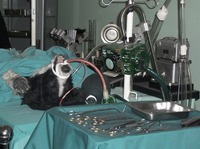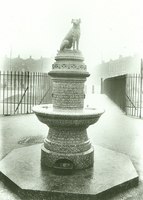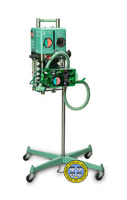Items
Site
The Medicine Chest
Is Part Of is exactly
Anaesthesia and Perioperative Medicine
-

Dogs in the Heart of Cape Town
The guided tour of the museum, which commemorates the first heart transplant performed by Chris Barnard in 1967, starts with a representation of the car accident that provided the heart for the transplant, through to the animal lab where Barnard conducted experiments with over 50 dogs to perfect the technique of heart transplantation. From there one can tour a model of Denise Darvall's bedroom and Christiaan Barnard's office before seeing a recreation of the surgery in the actual operating theaters where it occurred. -

The Brown Dog Affair (1903 - 1910)
On Feb. 2, 1903, English physicians William Bayliss and Ernest Starling, gave a lecture on the digestive system to a theatre full of medical students. Also in attendance were Lizzy Lind af Hageby and Leisa Schartau, committed feminists and anti-vivisectionists. They had travelled from Sweden to enrol at the London School of Medicine for Women, attend lectures around town, and document the practice of vivisection in British universities. During the lecture, a brown terrier was wheeled out, strapped to a board. Starling had already performed one experiment on the dog two months earlier, shutting off its pancreas. This time, Bayliss cut open the dog’s neck and spent half an hour unsuccessfully trying to stimulate the animal’s salivary glands with electrodes. Eventually, he gave up and handed the dog over to a student (Henry Dale, another future Nobel laureate) who stabbed it through the heart, thus ending the lesson. What followed was a court case filed by Stephen Coleridge, a prominent barrister and secretary of the National Anti-Vivisection Society against Bayliss. After four days of testimony, the judge called the women’s account “hysterical” while giving instructions to the jury. The jurors conferred for 20 minutes, then found Coleridge guilty of libel. Anti-vivisectionists commissioned a bronze statue of the dog as a memorial, unveiled in Battersea in 1906. Its plague, which read "Men and women of England, how long shall these Things be?" led to the it being vandalised on a frequent basis. On 10 December 1907, hundreds of medical students marched through central London waving effigies of the brown dog on sticks, clashing with suffragettes, trade unionists and 300 police officers, one of a series of battles known as the ‘Brown Dog’ riots. In March 1910, tired of the controversy, Battersea Council sent four workers accompanied by 120 police officers to remove the statue under cover of darkness, after which it was reportedly melted down by the council's blacksmith. -

Heart of Cape Town Museum
Christiaan Barnard did forty-eight trial transplants with dogs before he undertook such an operation with a human being. -

Bird Mark 7 Respirator
Dr. Bird invented a number of popular medical devices that were used to care for patients with breathing problems. During WWII he served in the Army Air Corps where, in addition to training and transport assignments, he studied aircraft and respiratory and cardiovascular problems at high altitude. Two devices that he produced during the war went into the design of his first commercial ventilator, the Mark 7 Respirator. Dr. Bird’s respirators and anesthesia ventilators have been used during many of the first human surgical procedures. Among these were the first open heart procedure and the first liver transplant. -

Compound of Tincture of Chloroform and Morphine
"Directions: For an adult, from five to ten minims may be taken in a wineglasful of water, and repeated in three to four hours, if necessary. In severe cases, the dose may be increased to fifteen minims. As this preparation contains potent posions, it should be used with caution". (As read on the lable of the bottle) "Action and Uses: In addition to its well-known use as an anaesthetic, Chloroform has been highly recommended for the relief of asthma, and in the form of vaporoles can be employed safely during the passage of calculi from the gall-bladder or kidney. The vaporoles are the most useful in obstetric practice. A vaporole may be crushed and the vapour inhaled from the palm of the hand" (BWC 1896: 38). "Morphine Sulphate: Anodyne. Use with caution. One swallowed gives great relief of pain"(BWC 1925:132).


